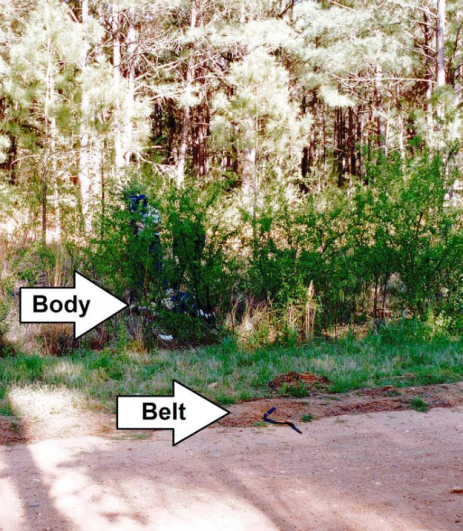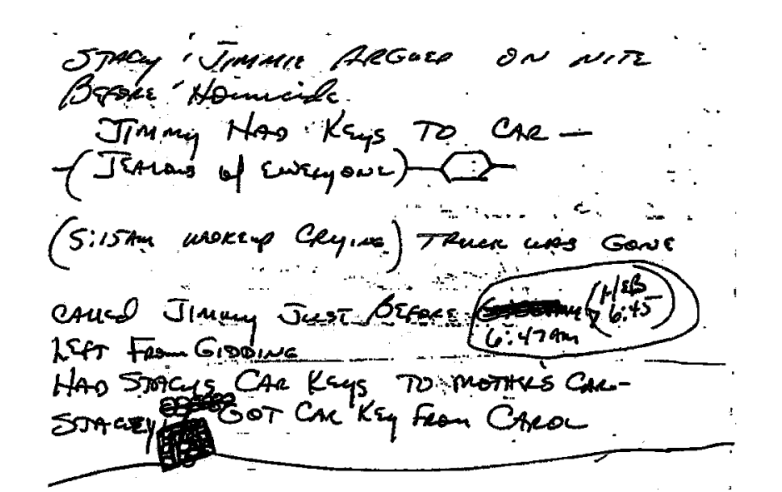
Mugshot/clemency petition Jimmy Fennell and a crime scene photo.
Jimmy Fennell was the then Texas police officer fiance of Stacey Stites, a young woman who was found brutally murdered and raped in 1996. Another man, Rodney Reed, was facing execution after being convicted of Stites’s murder. However, Reed’s supporters argue that Fennell is a plausible alternative suspect who had a history of violence against women, including on-duty.
After Stites was murdered, Fennell – who denies having anything to do with her death – ended up in prison for the on-duty rape of another woman. That behavior makes Reed’s supporters believe that Fennell was capable of the crime; they also argue that he had a motive to kill Stites if what Reed says was true: That he was having a secret romance with Stites behind Fennell’s back. They’ve presented new affidavits from people who say they knew of this romance, and they’ve presented new affidavits from people who say Fennell made disturbing comments about Stites, in one case, allegedly outright confessing.
The case has a racial overlay. Fennell is white, as was Stites and the jury. Reed is black, and his supporters argue that rage over an interracial relationship could have sparked the homicide. You can read Reed’s application for clemency here. Be forewarned that some of the crime scene photos in it are extremely graphic and disturbing.
Celebrities and some politicians have mobilized around Reed, including Rihanna and Kim Kardashian. Reed’s fate was in the hands of Texas Gov. Greg Abbott. He was supposed to be executed on November 20, 2019. The bipartisan Texas House Criminal Justice Reform Caucus wanted the execution stopped. The Texas Parole Board has now voted to recommend that Abbott delay Reed’s execution for 120 days. Then, the Texas Court of Criminal Appeals blocked Reed’s execution, according to CNN, arguing that a lower court should consider Reed’s innocence claims.
Reed was convicted largely on the basis of his DNA, via semen, being found in the victim’s body. He and his supporters say that’s because of the secret romance and claim he had consensual contact with Stites but didn’t murder her. Key in the case: The timeline, which Reed’s supporters now says shows he couldn’t have killed her and evidence about how long sperm can stay in a body, which they say proves he wasn’t the killer.
There is a Change.org petition that seeks to stop Reed’s execution. It’s been signed by more than 425,000 people. “The State of Texas wants to execute an innocent man on November 20, 2019. Rodney Reed was wrongfully convicted in 1998 of the rape and murder of Stacey Stites. He has sat on Texas’ Death Row for 2 decades,” the petition says, outlining evidence in the case.
Dr. Robert Bayardo, the Travis County Medical Examiner, determined that Stites died around 3:00 a.m. on April 23, 1996, but later clarified that time and it’s contested.
“The State’s theory at trial was that Reed’s DNA profile found in the semen deposited in Stites’s vagina and rectum and in the saliva on her breast clearly indicated that Reed had sex with Stites,” an appellate court decision in the case says. “And based on the injuries she suffered both pre- and post-mortem, the State argued that the sexual encounter was not consensual.”
“Mountains of evidence exonerates Rodney Reed,” the Free Rodney Reed website says. “All of that evidence was kept from the all white jury that convicted him. Instead, the evidence implicates the victim’s fiancé – local police officer Jimmy Fennell – who has a history of violence against women, including being convicted for kidnapping and sexual assault soon after Rodney was wrongly sent to prison.”
Here’s what you need to know about Jimmy Fenell:
1. Stacey Lee Sites Was Engaged to Fennell at the Time of Her Death & New Affidavits Describe Their Relationship as ‘Abusive’
Stacey Lee Stites faced a brutal ending. Her partially clothed body “was found on the side of a back country road in Bastrop County on April 23, 1996. She was wearing only a black bra, underwear, undone blue jeans, socks, and a single tennis shoe, and her H.E.B. name tag was found in the crook of her knee,” an appellate court decision in her case reads.
Found nearby: “A white t-shirt, a piece of a brown woven belt without a buckle, and two beer cans.” The court documents say that, before Stites’s murder, “she was engaged to Jimmy Fennell, a Giddings police officer at the time, and the two shared Fennell’s red pick-up truck.”
She was working the early morning shift at H.E.B, and she usually drove the truck to work. It was found at the Bastrop High School parking lot after she vanished. “Among other things inside the truck, authorities found Stites’s other shoe and broken pieces of a green plastic cup. Outside the truck, police found a piece of a brown woven belt with the buckle attached,” the documents say.
Both Reed and Fennell have criminal histories, though. Reed had been accused in other rape cases before his trial for Stites’s death but was not convicted; Fennell was convicted of kidnapping and raping a woman while on duty as a police officer in 2007, a crime for which he spent a decade behind bars, Reed’s clemency petition states.
Fennell was initially looked at by law enforcement. He said that she left for work in his truck, and authorities couldn’t figure out a timeline that would allow him to get back to the apartment where they lived, without his truck, in time to kill her, according to the Texas Tribune newspaper, adding that his lawyer has stated that the timeline doesn’t make sense for Fennell to be the killer. However, Reed’s clemency petition blows holes in the timeline and forensic testimony at trial.
Experts have questioned the initial time of death given for Stites.
Reed filed seven new affidavits in the case seeking a stay of execution, including testimony describing the Fennell/Stites relationship as abusive and difficult and additional testimony that underscores the assertion that Stites was engaged in an affair with Reed.

The crime scene
The timeline matters a lot in the case. Reed’s clemency application states that the search for Stites began “only a few hours” after she failed to report for a shift at a grocery store at 3:30 a.m. Fennell claimed he returned home from baseball practice between 8 p.m. and 8:30 p.m. and took a shower with Stites but didn’t have sex with her.
He claimed he went to sleep at 9 p.m. He claimed she took his truck to drive herself to work. The truck was found in a high school parking lot at 5:23 a.m., locked with the keys missing. The only fingerprints in the truck were from Fennell and Stites.
Just before 3 p.m. that afternoon, Stites’s body was discovered on an unpaved road. A T-shirt belonging to Fennell was found in the nearby brush.
The petition states that Fennell was pursued as a suspect and given two polygraphs “in which he was found deceptive on questions relating to Ms. Stites’s murder, after which he invoked his privilege against self-incrimination to avoid further questioning.”
Stites was described as “friendly, outgoing, and a flirt.” She had moved with her mother to Smithville, Texas from Corpus Christi after she became pregnant at age 15. She gave the baby up for adoption and completed high school. She started dating Fennell when she was in high school and he was 22 years old and working as a jailer. He went to her high school graduation and considered the relationship to be serious within two to three weeks after they began dating in May 1995, the petition alleges. Police reports say Stites “did not initially share this view” and had an “active social life” that included dating other men.
Reed has said that he had sex with Stites over a day before she was reported missing and was in a “casual sexual relationship” with her. His mother testified that she knew Reed was seeing Stites.
Reed’s defense attorneys outlined the follow statements:
A woman saw Rodney and Stites talking together at HEB.
A woman testified she was sitting on the front porch of Reed’s mother’s home when a woman identified as Stites came by asking for Rodney.
“Many of those claiming they had seen Reed and Stites together were Reed’s cousins or parents, and many had criminal felony or misdemeanor convictions for charges involving dishonesty, such as theft,” documents say. However, Reed has now identified three more credible witnesses with knowledge of his relationship with Stites.
Alicia Slater, formerly Griesemer, contacted Reed’s defense team, saying she was “morally compelled to tell someone” that she was aware of a sexual relationship between Reed, and her co worker Stites.

A crime scene photo of the body of Stacey Stites. Heavy has blurred out the most graphic parts. The photo shows the brutality inflicted on Stacey Stites.
“She told me that she was sleeping with a black guy named Rodney and that she didn’t know what her fiancé would do if he found out. She commented that she had to be careful.”
Lee Roy Ybarra stated that he also worked at HEB with Stites and on numerous occasions he saw Stites and a “young black man” he says was Reed. They seemed “happy and romantic.” When Fennell cwould come to the store, she “would become a nervous wreck” and even hide from him.
Calvin “Buddy” Horton is a cousin of Stites who says that, in 1995, he saw Stites leaving a Bastrop Dairy Queen with a black man. He claims this was Rodney Reed.
The Free Rodney Reed website explains, “Stacey Stites died in April 1996. Nearly one year later, Bastrop Sheriffs arrested a 29-year-old black man named Rodney Reed. He was charged with capital murder, citing DNA evidence matching Reed’s DNA to a small amount of sperm found inside the body. Prosecutors successfully argued that this was enough evidence to prove that Reed was responsible for her brutal sexual assault and murder.”
But prosecutors stand by their belief that Reed is guilty. “A large amount of credible evidence, including irrefutable DNA evidence, the testimony of witnesses, and the pattern Rodney Reed followed in committing his other sexual assaults, show beyond a reasonable doubt that he raped and murdered Stacey Stites,” lead prosecutor Lisa Tanner said to CNN.
2. New Witnesses Describe Fennell as Jealous of Stites & their Relationship as Problematic

A crime scene photo that shows Fennell’s truck.
In affidavits revealed in the clemency petition, Fennell was described as jealous and their relationship strained.
Heather Flanagan, a friend of Stites at the grocery store, said that Stites told her “Jimmy was a jealous type person who didn’t like her talking with other guys. They cancelled their wedding. Stacey never said why.”
Another friend, Tammy Hannah, told police that Jimmy Fennell “got upset with Stacey when he found out she was going out with her friends. Thinks Jimmy even slit her tires. Jimmy wouldn’t let her talk on the phone with her friends. Stacey always said she loved Jimmy. They would set wedding dates, then call it off.”
Stites would have coffee on Wednesdays with former co-worker Ronnie Reveal who stated that, less than a week before her murder, she told him she and her boyfriend were having problems and he had a “violent temper.”
Stacey’s mother indicated that Stites and Fennell had argued the night of the murder, and Fennell was “jealous of everyone,” an investigator’s note reads.

The investigator’s note, according to Reed’s clemency petition.
Fennell also changed his story about how full his truck’s gas tank was. Stites’ mother also insisted that Fennell had insisted on driving Stacey to work on the morning of the murder because he wanted his truck, but he denied this occurred, according to Reed’s petition.
Soon after Fennell’s truck was located but before Stacey’s body was found, Fennell “withdrew all the money in his bank account,” the petition states.
The state’s argument is that “Reed somehow intercepted Ms. Stites while she was en route to work, gained entry to the truck, sexually assaulted and strangled her (within a two hour window between 3 a.m. and 5 a.m.) without leaving fingerprints, hair or other evidence in the truck, and then transported her body to the remote location where it was discovered,” says the petition.
Additional review by forensic pathologists “places the time of Ms. Stites’ murder before midnight, when Fennell testified the couple was home alone together,” according to the petition, which also states that expert testimony that the sperm in Stites body was consistent with sexual assault were invalid.
Prosecutorial experts had contended that sperm can’t remain intact in a woman’s body for more than 24-26 hours, which gave no innocent explanation for the DNA because “Fennell’s testimony accounted for Ms. Stites over the prior 24 hours.”
In fact, according to the petition, sperm can remain intact for at least 72 hours. Fomer Travis County Medical Examiner Roberto Bayardo has recanted much of his trial testimony, according to the petition.
He had testified that the semen was left “quite recently,” but now admits that forensic evidence suggested that the intercourse occurred more than 24 hours before her death.
Three leading forensic pathologists now believe that Stites was murdered before midnight, and she was placed where she was found at least four hours after the murder, which would make the state’s theory of Reed’s guilt “impossible.”
“If Ms. Stites was murdered at a time that Jimmy Fennell testified that she was at home with him, and if there is no evidence that Mr. Reed sexually assaulted Ms. Stites, then it becomes clear that Jimmy Fennell and not Mr. Reed murdered Ms. Stites,” the petition states.
Lividity and blanching on her body led to the determinations, as did decomposition. The petition also claims that some of the crime scene details appear staged, such as placement of her name tag between her legs.
3. Witnesses Now Say Fennell Made Extremely Disturbing Statements About Stites & He Was Accused of Abusing Other Women

Jimmy Fennell
Charles Wayne Fletcher, a Bastrop Sheriff’s Officer, has given an affidavit stating that Jimmy said that he believed Stacy was “f*cking a n*gger.” The conversation occurred at a barbeque.
Fennell gave inconsistent comments about his whereabouts, the petition says. He told a fellow law enforcement officer, Mary Blackwell, that he would kill his girlfriend if he ever caught her cheating, it adds.
He’s accused of saying he would “strangle her with a belt” so as not to leave fingerprints on her throat.
An insurance salesperson said that Fennell threatened to kill Stites when she offered the couple life insurance. He was working security at the time and allegedly stated, “If I ever catch you messing around on me I will kill you and no one will ever know it was me that killed you.”
Jim Clampit, a former Lee County Sheriff’s Office Deputy, states he witnessed Fennell looking over Stites body at her funeral and saying something like “you got what you deserved.”
Richard Scroggins says he saw Fennell call Stites “obscene and vulgar names” while in a “tirade.”
Pamela Duncan, who dated Fennell after Stites’s murder, described him as “extremely possessive and jealous” and he would threaten men who flirted with her.
“He was very verbally hostile to me…and would scream at me in public. He didn’t like me going out with my friends,” she said, adding that he was “extremely prejudiced” and used the N word, calling black people “all bad, all on drugs, all crooks.”
She claimed when she broke up with him he stalked her “for months” and would shine a spotlight into the house. He would stand outside her house at night, screaming and calling her obscenities. He would pull over a man she started dating and give him tickets, it’s alleged in the petition.
She said she filed a harassment report against him, the petition says.
He was accused of physical abuse against his wife Aida Fennell. A co worker of Aida told the Williamson County Sheriff’s Office that Aida Solano Fennell had previously worked at the juvenile justice center but then quit. It was rumored at the time that her husband Fennell and another employee, Keith Tubbs got into a verbal argument on the phone about Aida.
Tubbs said that Jimmy called and questioned him about calling his house, which Tubbs did not do. He asked if Aida was seeing someone, and it was revealed she had previously shown up at work with bruises on her face and “claimed it was a result of being hit in the face by a phone when Jimmy became upset and threw a phone at her.”
4. Fennell Was Later Sent to Prison on a Different Crime, an On-Duty Rape
Fennell was later sentenced to a 10-year prison term for kidnapping and sexually assaulting a woman while he was on duty as a police officer in 2007. He was a Georgeton police sergeant at the time.
In the 2007 case, Fennell was accused of responding to a domestic fight at an apartment complex in Georgetown. The boyfriend of a woman was arrested and the intoxicated girlfriend was handcuffed. She thought the officer was going to take her to a hotel, according to Reed’s petition, which further alleges:
Instead, she said Fennell took her to a park, asked her to dance for him outside of his patrol unit, had her place her hands on the trunk of his patrol unit, pulled down her parents and had sex with her from behind. He asked if she liked it, and she said no but he didn’t stop. Then, he drove her back to her apartment, and she reported the assault by calling 911.
Her prints were found on his trunk. His whereabouts were unaccounted for during the critical time frame.
In another case, Fennell was acused of strip searching a woman while an officer and then raping her. In 2004, he was accused of pulling over a woman for having a crooked license plate and asking her to remove her clothes and dance with him.
She extricated herself by telling Fennell she knew the sheriff’s wife. She gave a statement to a sheriff’s officer but the case was closed for unclear reasons, the petition alleges
There was another accusation in which he made an alleged sexual assault threat. He was the target of “civil rights complaints alleging racism and violence,” including being accused of “chasing down, beating and putting a gun to the head of a young Hispanic man,” claims the petition, although none of these other accusations appear to have been charged.
Prior accusations against Reed were leveled at the punishment phase, but his petition states he was not convicted and was acquitted in the only matter prosecuted.

Fennell’s court records in the case from Williamson County, Texas.
The woman in the 2007 case later spoke to documentarian Ryan Polomski.
Reed’s attorney Bryce Benjet told the Austin Chronicle in 2008: “Jimmy Fennell has now twice confessed to committing this crime of sexual violence. Mr. Fennell’s conviction for this crime is consistent with his long history of violence and the ample evidence that made him a suspect in the murder of Stacey Stites over a decade ago. … Mr. Fennell’s recent confessions are certainly relevant in demonstrating Mr. Reed’s innocence.”
However, in 2008, when Fennell was convicted of the on-duty rape, his attorney, Bob Phillips, challenged those who think Fennell killed Stites, not Reed. “That’s the same Rodney Reed who originally denied even knowing the dead girl until being confronted with the fact that his semen was inside her vaginal vault,” Phillips said to My Plainview. “Then his statement was ‘Oh, that Stacy Stites, that’s the one I was having an affair with.’ So is a convicted killer and notorious liar who is trying to avoid the death penalty at any cost, including straining the credulity of any thinking person, to be believed?”
The 2008 story reported that Fennell agreed to give up his peace officer’s license in exchange for not becoming a registered sex offender. The original charges, were stiffer than those Fennell was convicted of committing. According to My Plainview, he was convicted of kidnapping and improper sexual activity with a person in custody.
Ancestry records show that Fennell was married in 2000 in Texas. He was born in Texas.
In 2018, the Statesman reported that Fennell was set to be released from prison. A Texas parole board had denied him parole 10 times but then agreed to “allow early release with the strictest form of supervision,” the newspaper reported. He was released in March 2018 from prison, according to KXAN-TV.
“Jimmy’s looking forward to resuming his life with his family in a quiet and peaceable environment having paid for the crime that he actually did commit,” his attorney told KXAN.
5. Fennell Is Accused of Confessing That He Murdered Stites to a Former Member of the Aryan Brotherhood

Rodney Reed
An inmate who served time with him later stated in a sworn affidavit that Fennell confessed that he killed Stites.
You can read the affidavit, obtained by the Statesman, here.
In it, Arthur J. Snow Jr. states that he has been in and out of jails and prisons “for much of my life” and was an inmate serving time for forgery at the Stevenson Unit in Cuero, Texas from December 2010 to about September 2011.
He added that he was “brought up to be prejudiced against black people.”
He joined the Aryan Brotherhood prison gang. He wrote that he became a “sort-of” leader of the gang.
In about 2010, a white man named Jimmy Fennell approached him wanting the protection of the Aryan Brotherhood from “the blacks and Mexicans at the prison,” according to Snow.
Snow’s affidavit said that Jimmy “seemed out of his element” so he cut a deal with Jimmy to pay the Aryan Brotherwhood out of his commissary in return for protecting him from violence.
His affidavit alleges that they weren’t really friends but occasionally made conversation and one time they were talking in the rec yard when he says that Fennell was talking about his ex-fiance with “a lot of hatred and resentment.” He said she had “been sleeping around with a black man behind his back.”
Toward the end, according to Snow, Fennell said, “I had to kill my (n word)-loving fiancé.”
He assumed Jimmy thought the confession would “earn him credibility with the Aryand Brotherhood.” But once the Aryan Brotherhood learned Fennell was a cop and rapist, they decided not to protect him anymore and Fennell accused the Aryan Brotherhood of extorting him, so he was moved to another unit.
He claims he later saw Fennell’s picture in the newspaper and learned about the Reed case. He didn’t come forward then because he didn’t want to be labeled “a snitch,” and decided it was none of his business.
As he aged and the years passed, he had grandkids and “let go of some of my prejudices.” He “tried to put myself in Rodney Reed’s shoes.” Eventually, he decided to come forward with his allegations.
The affidavit is dated October 29, 2019.
The Statesman newspaper also says that, in the Stites’ case, police didn’t search the apartment Stites shared with Fennell and gave him back his truck without thoroughly processing it.
Through his lawyer, Fennell has repeatedly denied having anything to do with Stites’ death, according to The Statesman.
Department of Public Safety (DPS) crime scene investigators Karen Blakley, Wilson Young, and Terry Sandifer handled the investigation early on.
Blakley testified at trial that the murder weapon was the belt “[b]ecause it matched the pattern that was on [Stites’s] neck,” the appellate court decision reads. “Blakley also concluded that the two belt pieces matched and were torn, not cut.”
Blakley also presumed that there was a sexual assault because Stites was partially clothed and her pants were ripped open. “At the scene, Blakley further observed Stites’s underwear was wet in the crotch and bunched around her hips, so she tested the crotch of the underwear for semen,” the documents say.
“Getting a positive result, Blakley collected DNA samples from Stites’s vagina and breasts. Blakley did not collect samples from Stites’s rectum because rigor mortis had already set in. Blakley also observed scratches on Stites’s arms and abdomen, a cigarette burn on her arm, and what appeared to be fire ant bites on her wrists. To preserve any DNA evidence under her fingernails, DPS investigators put plastic bags over Stites’s hands,” the document state.
In addition, investigators determined that a person 6 foot 2 inches or taller had driven the truck due to the way that the driver’s seat was pushed back.
The medical examiner also believed the belt was the murder weapon and that it was used to strangle Stites. “Like Blakley, Bayardo presumed Stites was sexually assaulted, took vaginal swabs, and found sperm with both heads and tails intact,” the court records say. “He also took rectal swabs but found only sperm heads with no tails. He noted that her anus was dilated with superficial lacerations. Dr. Bayardo thought the presence of sperm in the anus was indicative of penile penetration, but noted that it may have been attributed to seepage from the vagina. He concluded that Stites’s anal injuries occurred at or around the time of death and therefore were not acts of consensual sexual activity.”
According to the Innocence Project, “The three forensic experts from Reed’s original trial have submitted affidavits that the original time of death is inaccurate, which makes the timeline for Reed killing Stites implausible.”
In addition, the Project states, “Renown forensic pathologists including Michael Baden, M.D., Werner Spitz, M.D., LeRoy Riddick, M.D., and Cyril Wecht, M.D. have all concluded that Reed’s guilt is medically and scientifically impossible. The prosecution’s only forensic evidence linking Reed to the crime was semen taken from Stites’s body, which was attributed to the consensual relationship between them. The prosecution used this to connect him to the murder and refute this consensual romantic relationship, but supporting testimony has since been recanted and completely discredits the state’s case.”
The Project adds, “The murder weapon has never been tested for DNA evidence. Requests for DNA testing of crime scene evidence, including a belt that was used as the murder weapon has been repeatedly denied by the Texas Court of Criminal Appeals. In 2018, the United States Supreme Court declined to directly review the Texas courts’ denial of DNA testing.”
Over the course of an 11 month investigation, police obtained 28 DNA samples from different men, but none of them matched the crime scene evidence. They initially worked on ruling out people Stites knew personally.
They started focusing next on Reed because he was about the same height as the estimate for the suspect, lived near the high school and “frequently walked the area late at night,” the appellate decision states. “Police learned from DPS that Reed had an existing DNA sample on file and had DPS test it against the vaginal swabs taken by Blakley. Two different DNA tests of the samples concluded that Reed could not be excluded as a donor of the semen,” the documents allege.
Those results were sent to a lab for more testing, and again it was determined that “the results could not exclude Reed and…that the samples matched Reed’s genetic profile.”
“Rodney has steadfastly maintained his innocence from Day 1,” insists the Free Rodney Reed website. “Absolutely zero evidence exists that Rodney had anything at all to do with this crime. He was in a consensual relationship with Stacey Stites and the only DNA of Rodney’s that was found was from this consensual relationship. The prosecution, citing that DNA persuaded an all-white jury of his guilt; he was convicted and sentenced to die by lethal injection. Currently, he is scheduled to die in just a few days on November 20, 2019.”